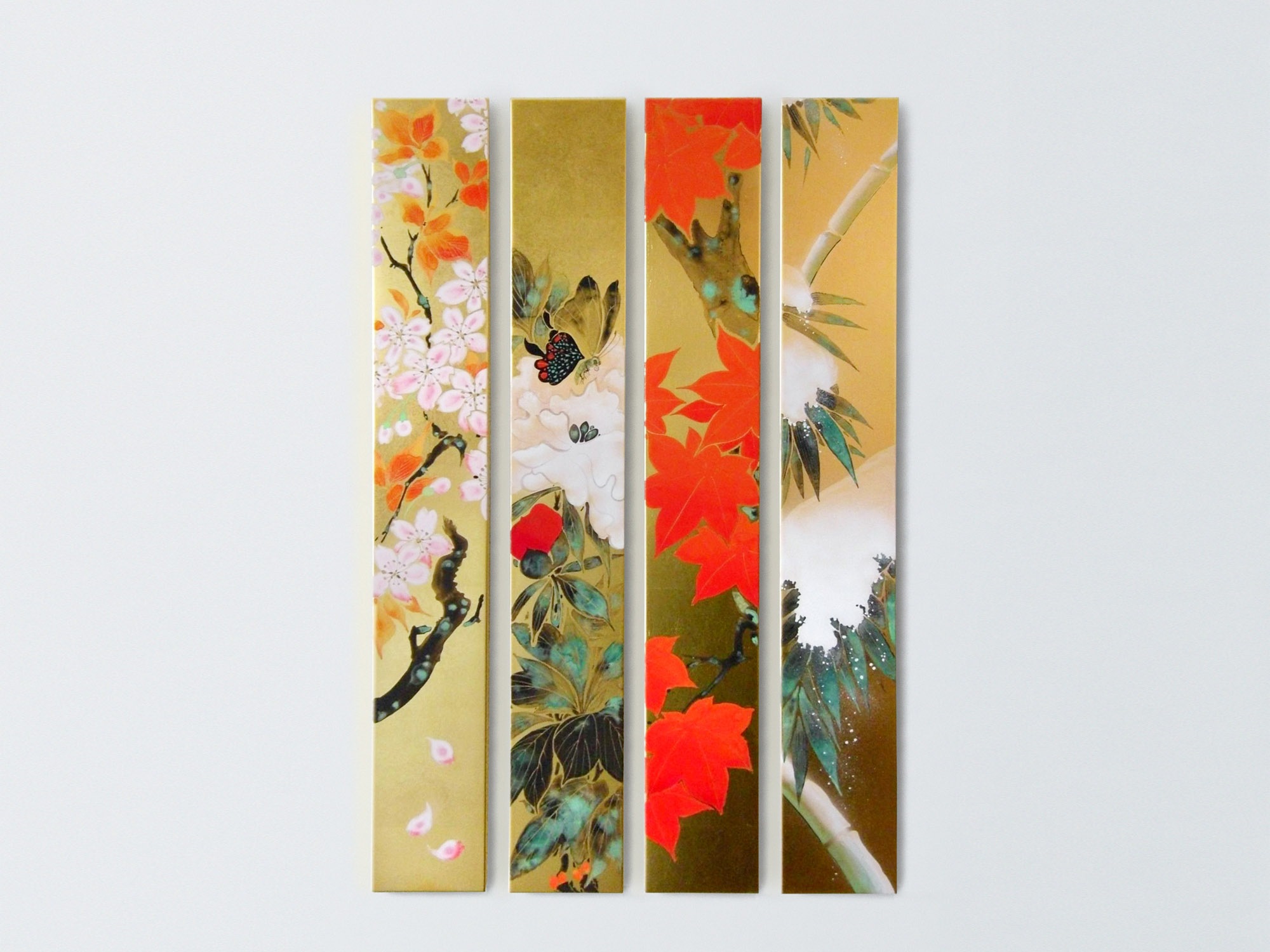Colored/Maki-e Art Panels

These art panels are thin rectangular boards decorated with gold leaf and then treated with colors and maki-e. Images of flowering plants in each of the four seasons are particularly admired in Japan, where people hold deep affection for artworks depicting nature.
The black panels feature motifs of mountains and water created using maki-e. These pieces introduce a traditional and sublime brilliance into any space using inlaid mother-of-pearl.
| Title | Colored/Maki-e Art Panels |
|---|---|
| Date | 2009.04 |
| Theme | Art panels/interior |
| Techniques | Woodworking, finishes, gold leaf, maki-e, coloring |
| Materials | Veneer board, cashew finish, gold leaf, gold powder, natural mineral pigments, varnish |
Integrated traditional materials and techniques
Veneer board, which is unlikely to warp or break, is used for the frame. Cashew oil is applied for the finish, and matte paint is used under the gold leaf to set off the glossy finish of the leaf. Real gold leaf was used and has been coated with varnish to prevent it from peeling off. The maki-e images are drawn using gold powder and matte maki-e and have also been varnished for protection.
Woodworking
Working with unfinished wood is an important initial process for creating the foundation or frame of a product.
Woodworking at INOUE is based on the exacting quality found in the traditional arts that have been cultivated by the production of Buddhist altars in the castle town of Hikone since the Edo Period (1603-1868 CE). Craftsmen produced these altars by hand and without nails, demanding uncompromising quality in the careful selection of the best materials for use in mortise and tenon construction. These altars are durable enough to be handed down through many generations. Furthermore, we have connections with woodworking shops in other areas that specialize in mass production, allowing us to select the appropriate methods of woodworking for any project.Maki-e
Maki-e is an artistic lacquer technique that involves drawing pictures or patterns using lacquer and then sprinkling them with gold dust or other fine powders. Maki-e originates in Japan and is one of the unique traditional techniques developed here. Maki-e includes many subsidiary techniques, such as hiramakie, takamakie, and togidashimakie. Furthermore, maki-e includes a wide variety of different end products, such as the expression of depth through different types or sizes of gold powder and the application of a variety of processing techniques.
At INOUE, we have built a network of maki-e craftsmen with a wide range of skills, allowing us to provide the skills needed for any project, from projects demanding the utmost quality to those needing to fit into a tight budget.Gold plating (Hakuoshi, hakuhari, or hakuoki)
Hakuoshi is a decorative technique for covering items with gold or silver leaf or platinum foil.
While the material is called “gold leaf,” it includes a variety of types. These range from gold with a high degree of purity to silver admixtures that allow for an adjustment of the foil’s color. Techniques for applying the gold leaf include methods that bring out the luster of the foil as well as methods that create an elegant or refined appearance.
At INOUE, veteran craftsmen employ a wide variety of methods for gold leaf application. We have also developed techniques for the application of gold leaf to modern materials, such as acrylic resin and glass.Finishes (cashew, urethane, etc.)
At INOUE, the quality of our finishes is consistently and carefully scrutinized with a watchful eye. From sophisticated traditional techniques such as base coats of natural lacquer to cashew finishes made with the natural resin of the cashew tree, also a member of the lacquer family, to urethane finishes made with synthetic resins, we provide a wide variety of finishing techniques.
Given our extensive network of craftsmen with unparalleled technical skill, we can fulfill requests for finishes of nearly any kind.Coloring
Coloring techniques involve drawing images and colors on top of wood, lacquer, or gold leaf using the traditional vibrant pigments of Japan. The resulting colors are remarkable for their matte finish. Depending on the design, coloring can be applied to further enhance a variety of different products.